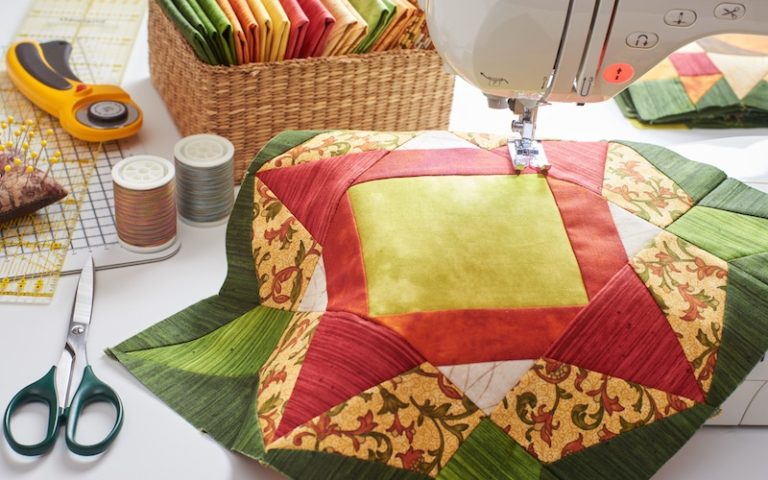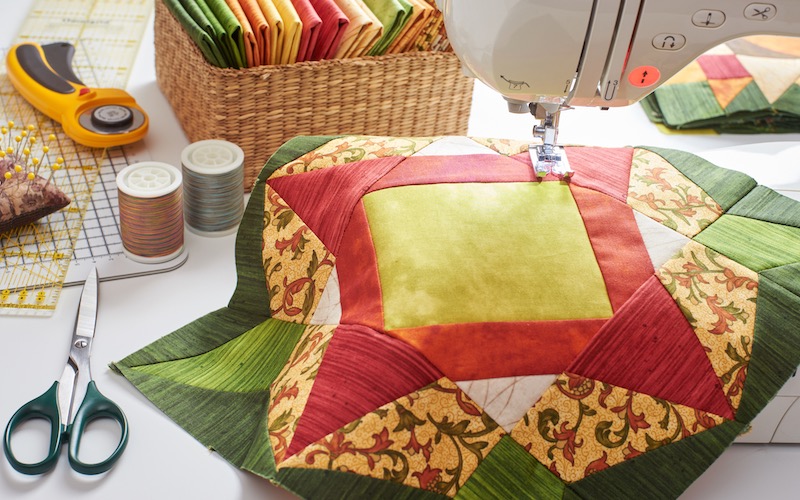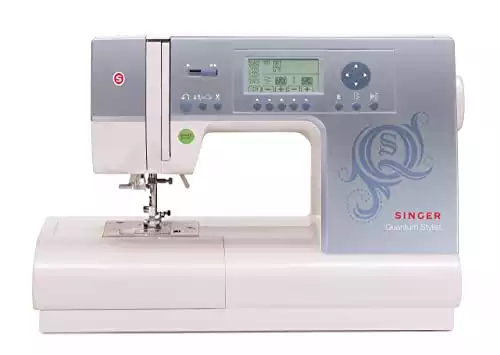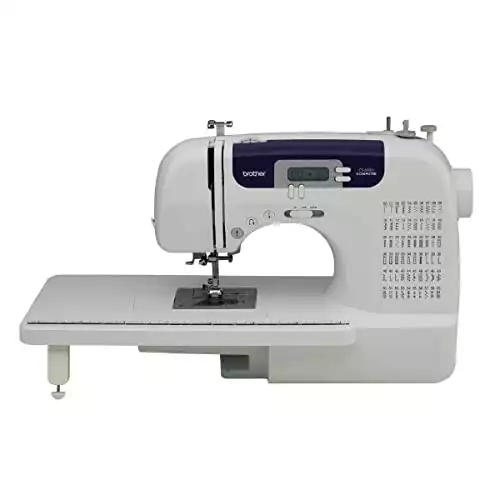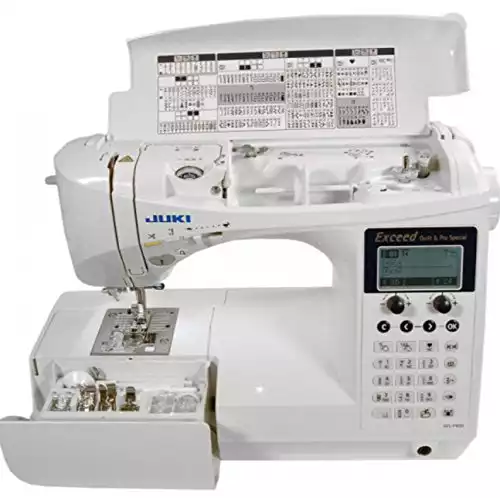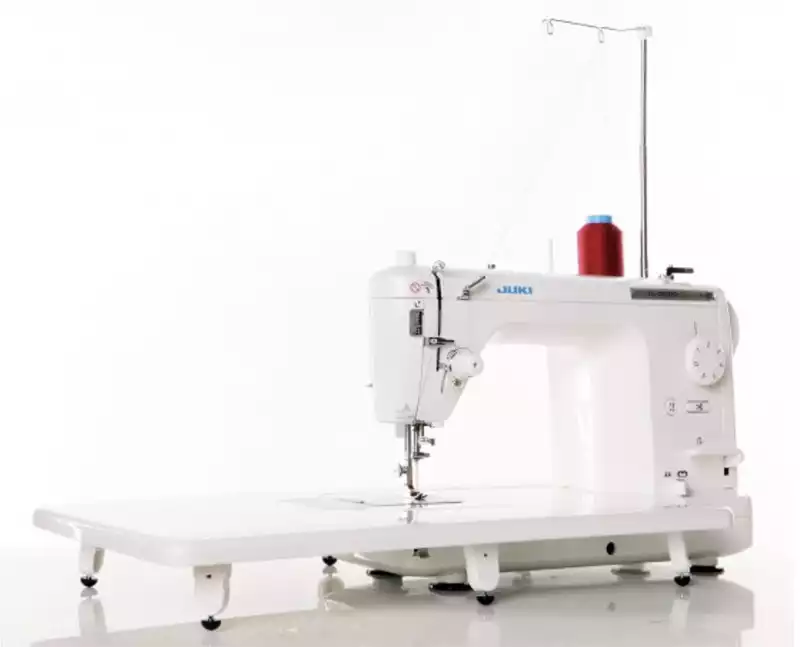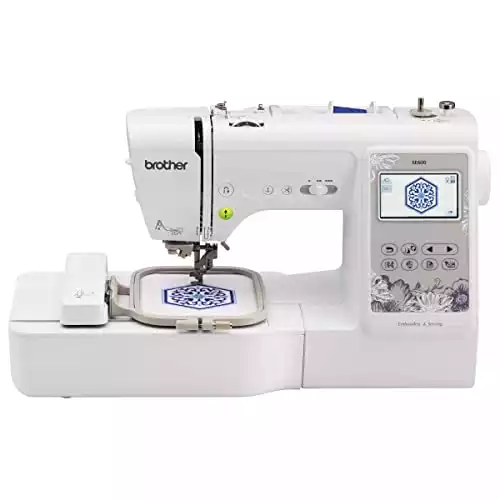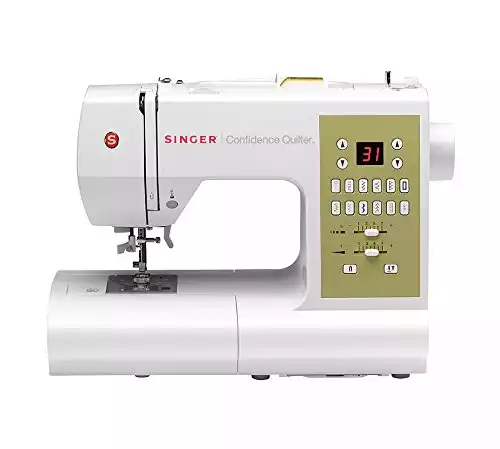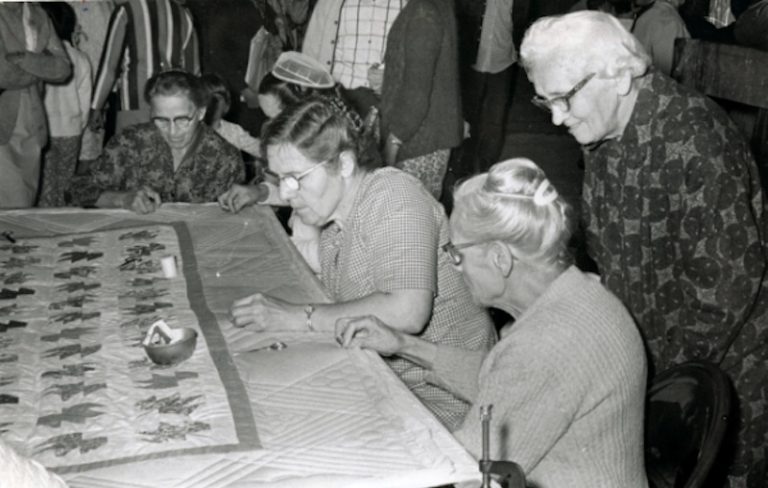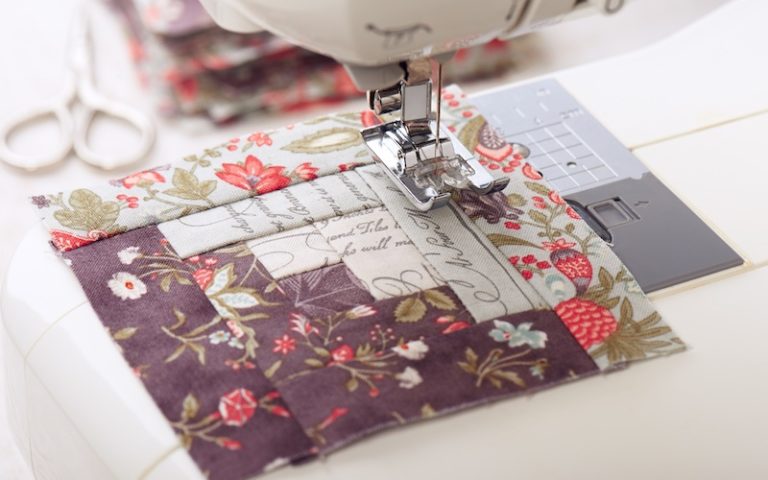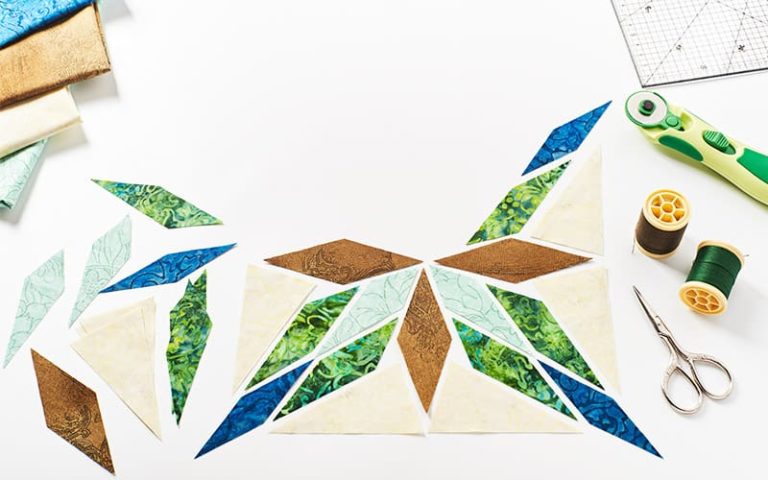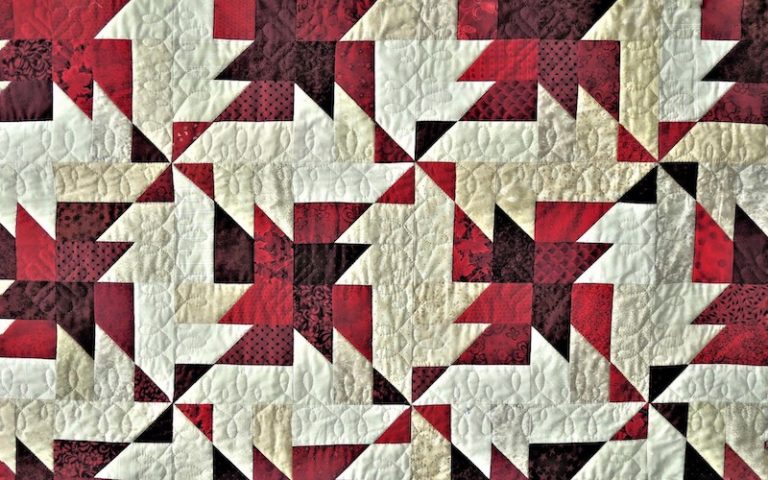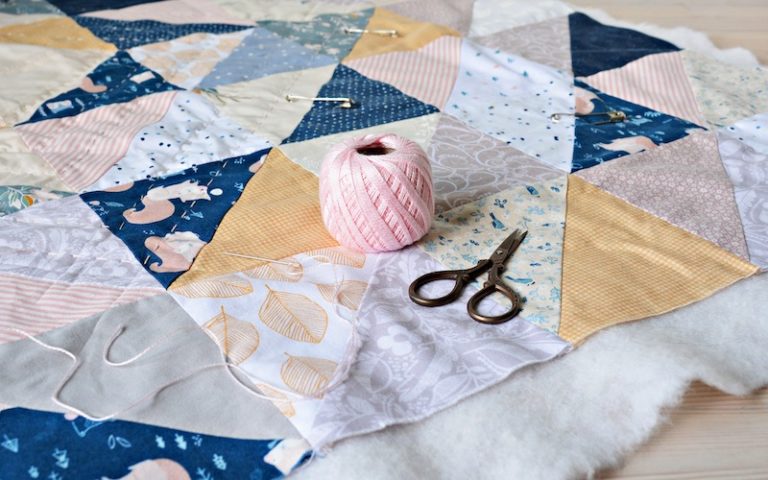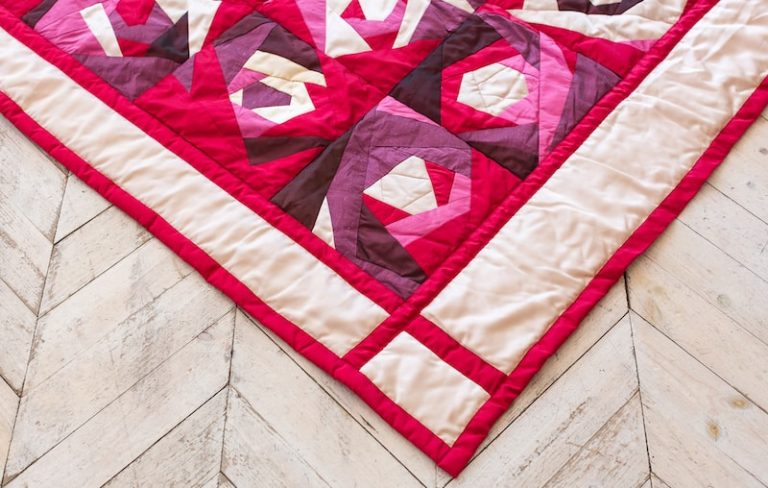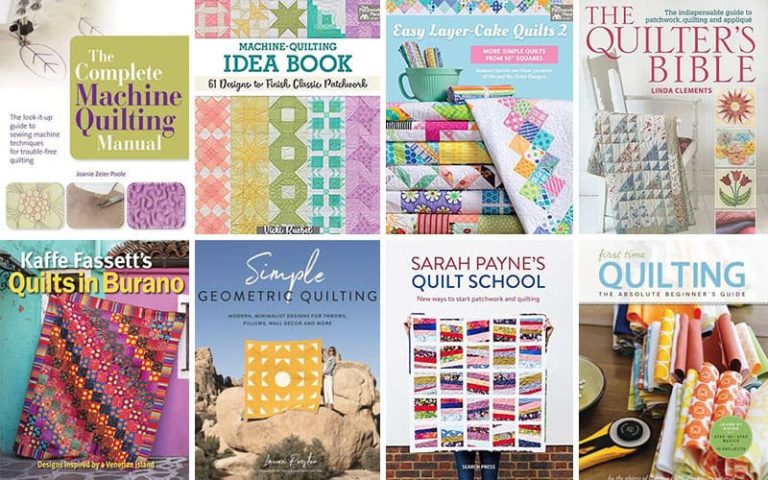Quilting has long been a beloved form of handicraft, and this has seen a resurgence in popularity in recent years.
Whether you are an advanced quilter, a complete novice, or an experienced sewer looking to branch out into quilting, there is much to consider when buying a quilting sewing machine.
The best sewing machines for quilting
When looking for the best sewing machine for quilting, you’ll find a large number of options available. The best model for you will depend on a few different factors, such as your level of experience, and the other tasks you want to use it for.
1. Best Overall: Singer Quantum Stylist 9980 Computerized Sewing Machine
Read our full Singer Quantum Stylist 9980 Computerized Sewing Machine Review.
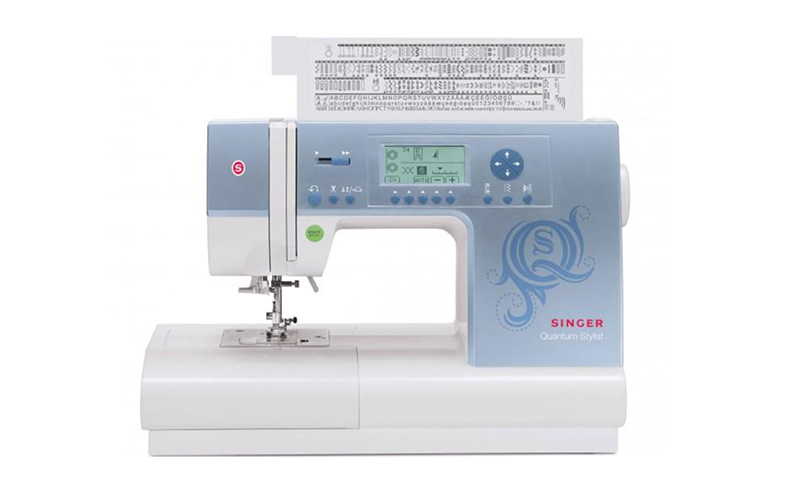
The Singer Quantum Stylist 9980 is a computerized sewing machine that is well-suited to sewing, quilting, and embroidery. It comes with an impressive 820 built-in stitches, from basic stitches to embroidery designs.
The built-in stitches include five distinct alpha-numeric fonts. Although, it should be noted that, unlike many other computerized sewing machines, the Singer Quantum Stylist 9980 doesn’t allow you to download additional stitches.
Along with having a large range of stitches to choose from, you’ll also be able to do them fast, with a maximum sewing speed of 850 stitches per minute. Despite being powerful and durable, the Singer Quantum Stylist is also nice and quiet.
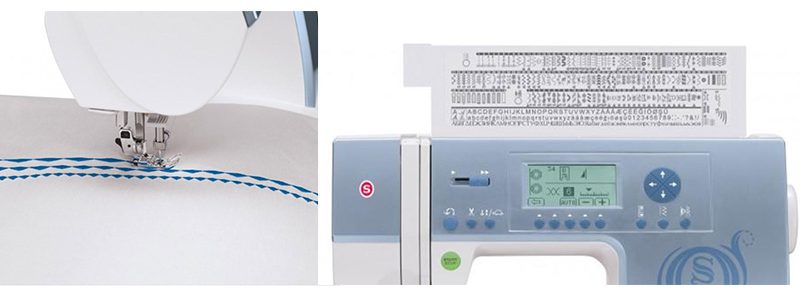
This sewing machine offers a large number of accessories which make it suitable for a range of sewing techniques, including quilting. There are 13 different sewing feet included – far more than most sewing machines offer. Among other presser feet, this sewing machine comes with a straight stitch/quilting foot and an even feed foot.
This sewing machine model comes with a large number of features that make quilting quicker and easier, including:
- start/stop button
- automatic needle threader
- presser foot sensor
- needle stop up/down setting
- ability to drop the feed dogs for free motion quilting
The ability to stop the needle in the down position is particularly useful when quilting, as it allows you to navigate sharp corners and other tricky quilting techniques. The drop feed feature helps control the movement of the fabric which comes in handy for free motion quilting.
You can also choose between 25 different needle positions, giving you greater control over your stitches. This is particularly useful for zigzag stitches, as well as any kind of precise work.
What we like:
- 820 built-in stitches: This machine offers an impressive number of basic and decorative stitches including five alpha-numeric fonts.
- Fast stitch speed: The 9980’s powerful motor produces up to 850 stitches per minute.
- Durable but quiet: Although strong and capable of handling robust fabrics at high stitch speeds, this machine runs quietly.
- Automatic needle threader: Easy threading feature is the biggest timesaver as it makes threading the eye of the needle just a breeze.
What we don’t like:
- Thread cutter: The Quantum Stylist 9980’s built-in thread cutter is rather problematic, with a tendency to unthread the needle.
The Singer Quantum Stylist 9980 sewing machine also comes with an automatic thread cutter. Automatic thread cutters can make quilting and sewing much more efficient, meaning you can quickly move from one seam to the next.
However, the automatic thread cutter on this model has a fairly major issue: using it tends to unthread the needle. This, unfortunately, makes this feature rather less efficient, rather than being the time-saver it is designed to be.
That being said, it’s still a great sewing machine that’s able to tackle and create diverse projects. The vast array of stitches and fast speed, coupled with the handy features are what makes the Singer Quantum Stylist 9980, earning it a spot on our list of the best sewing machines for quilting.
2. Best for Beginners: Brother CS6000i Sewing And Quilting Machine
Read our full Brother CS6000i Sewing And Quilting Machine Review.
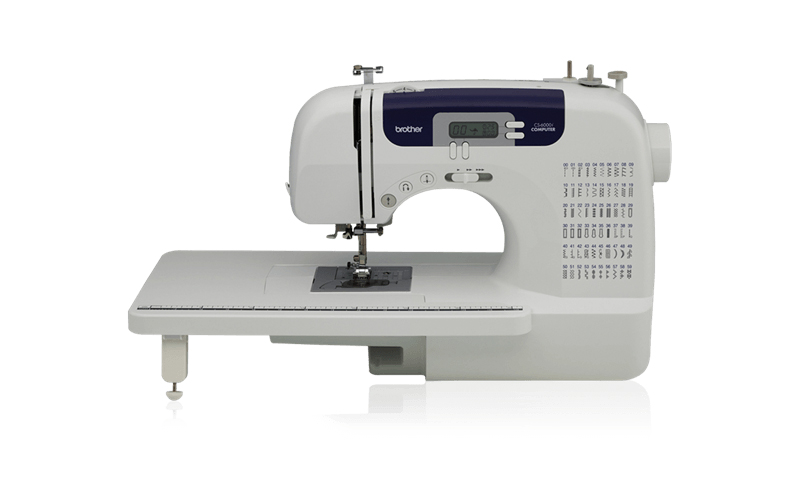
This incredibly popular and affordable computerized machine is equally suited to quilting and sewing. The Brother CS6000i is a beginner-friendly sewing machine that has a large number of functions and features that make it easy to use, as well as great for novice sewers wanting to learn how to quilt.
This machine comes with a large extendable work table, giving you plenty of room to work on your quilts.
The Brother CS6000i comes with a needle set and 8 sewing feet, including a walking/even feed foot and spring-action quilting foot, both useful for creating polished quilting projects. It also comes with a quilting guide to let you sew perfectly-spaced rows of stitches.
Being a computerized sewing machine, you can use its LCD screen to switch between 60 built in stitches or select other functions easily. The Brother CS6000i’s LCD screen has a streamlined interface that all levels will find simple to use.
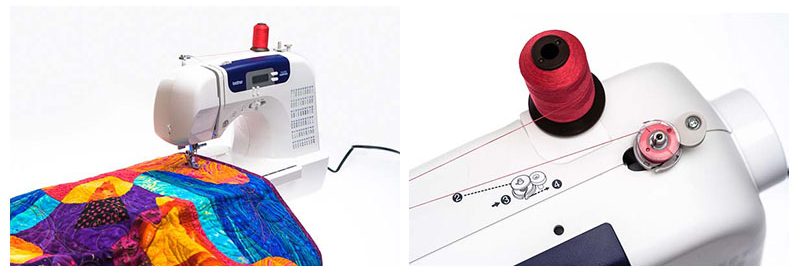
The Brother CS6000i has an automatic needle threader, an easy to use bobbin winder, and convenient push-button controls. The latter makes sewing quicker and more efficient, allowing you to start, stop, reverse, and change speed without needing to balance the delicate foot pedal.
This user-friendly sewing machine with 60 built-in stitches, includes a range of decorative stitches to embellish your quilting projects.
Another beginner-friendly feature is the Brother CS6000i’s adjustable sewing speed. This makes it easy to select your desired stitch speed, up to a maximum of 850 stitches per minute. This means you can keep stitching speeds low as you get used to sewing and quilting.
The Brother CS6000i is very lightweight, making it an extremely portable sewing machine. Coming with a hard protective case also makes it easy to take with you to a sewing class or sewing bees.
What we like:
- Beginner-friendly: This computerized machine is very easy to use and a great model for those who are learning to sew.
- Push-button controls: You can choose to use the foot pedal to sew, or start and stop stitching with user-friendly buttons.
- Speed control: Beginners or anyone doing intricate work will appreciate the ability to slow down the sewing speed.
- Extension table: You’ll be able to expand your work space when needed with the included quilting table extender.
What we don’t like:
- Thread tension: The Brother CS6000i’s tension can be difficult to control and may cause thread puckering or other issues.
In terms of disadvantages, the Brother CS6000i’ tension can be a bit tricky to get right. This can be managed, however, by making sure to always thread the machine with the presser foot and needle in the up position.
Overall, the Brother CS6000i is a sturdy machine and much more durable than you might think it would be as an affordable and lightweight, computerized sewing machine. This means it can be easily used for heavy duty sewing projects such as sewing through robust fabrics like denim and upholstery.
3. Best for Advanced Quilters: Juki HZL-F600 Exceed Sewing and Quilting Machine
Read our full Juki HZL F600 Sewing And Quilting Machine Review.
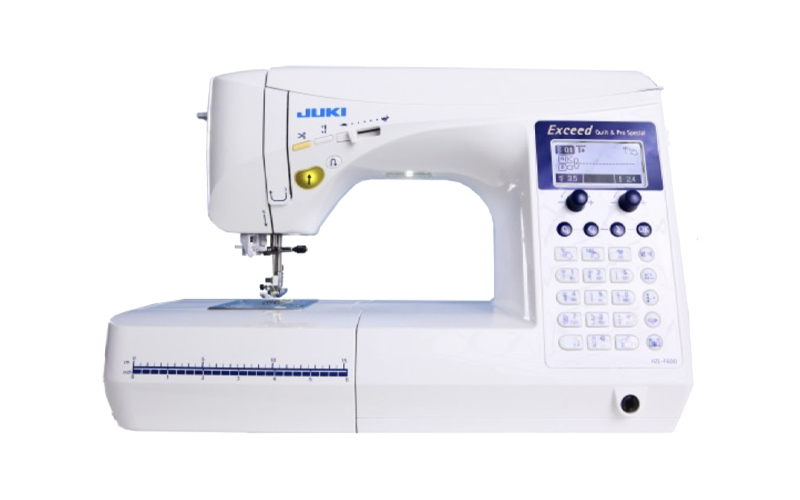
The Juki HZL-F600 Exceed is a versatile sewing and quilting machine with many features that will appeal to even expert quilters.
Juki is known for its industrial sewing machines, and it has applied this industrial expertise to deliver some high-level technology in the Juki HZL-F600.
This sewing and quilting machine comes with a very large extended sewing table, wider than even most quilting machines. This is very useful for quilters as it provides even more room to work on your large and complex quilting projects.
The Juki HZL-F600 comes with a very impressive 225 basic and decorative stitches. This includes three alpha-numeric fonts and an impressive 16 built-in one step buttonholes. You can also easily drop the feed dogs for free motion quilting, and special settings to keep the thread tension stable for precise free motion sewing.
There are 10 sewing feet included with this machine, including a patchwork foot, a free motion foot, zipper foot and a walking foot that is ideal for quilting. You can also easily adjust the presser foot pressure, and so avoid puckering and similar tension problems.
You can easily manage stitch selection and other functions by using the machine’s large LCD display. Particularly handy is the direct stitch pattern selector which lets you quickly choose from frequently used stitch patterns. You can also ask the Juki HZL-F600 to select stitch width automatically, for a random, interesting appearance.
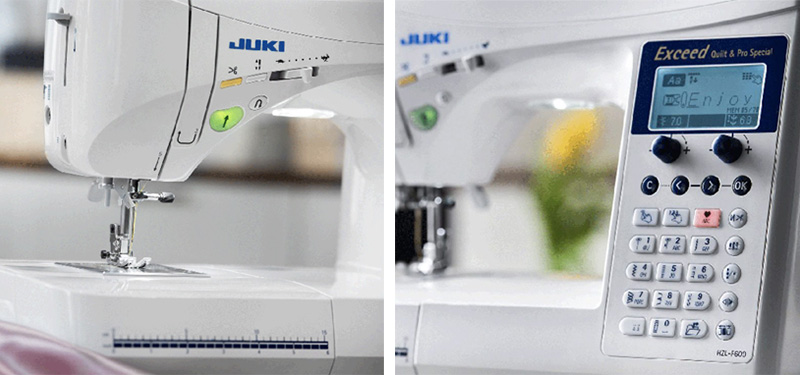
Other features of the Juki HZL-F600 which make quilting easier include:
- automatic needle threader
- easy bobbin winding with an independent motor
- automatic thread cutter
- dual LED lights that brightly illuminate the sewing area.
Its knee-lifting lever allows you to raise or lower the presser foot quickly with your knee, keeping your hands free for other tasks.
Another very strong advantage of the Juki HZL-F600 is its box feed technology. This unique system, distinct from the standard oval-feed technology found on most sewing machines, prevents your fabric from shifting or shrinking during sewing.
On the downside, the Juki HZL-F600 is not the simplest sewing machine, nor is it the easiest to use. This means that, although intermediate and advanced sewers will revel in this machine, beginners may find it overwhelming.
What we like:
- Box feeding system: This advanced feeding system means that fabric is fed more smoothly for perfect, even stitches.
- Large LCD display: This larger-than-average display screen makes it easy to select stitch width, length and type.
- Knee lifter: Being able to lift the presser foot with your knee means you keep your hands free and makes you more efficient.
- Extendable work table: The wide table gives you more room to work on large, bulky quilts.
What we don’t like:
- Not beginner-friendly: This models many features can be complex and overwhelming for novice sewers.
- Relatively expensive: This is certainly not the cheapest sewing and quilting machine on the market.
This sewing machine also is not the cheapest model on the market. Although it represents good value for money, the price may be prohibitive for beginners in particular.
For beginners looking to learn to quilt, there are other models that are arguably more suitable, such as the Brother CS6000i.
4. Best for Power: JUKI TL-2000Qi Sewing and Quilting Machine
Read our full JUKI TL-2000Qi Sewing And Quilting Machine Review.
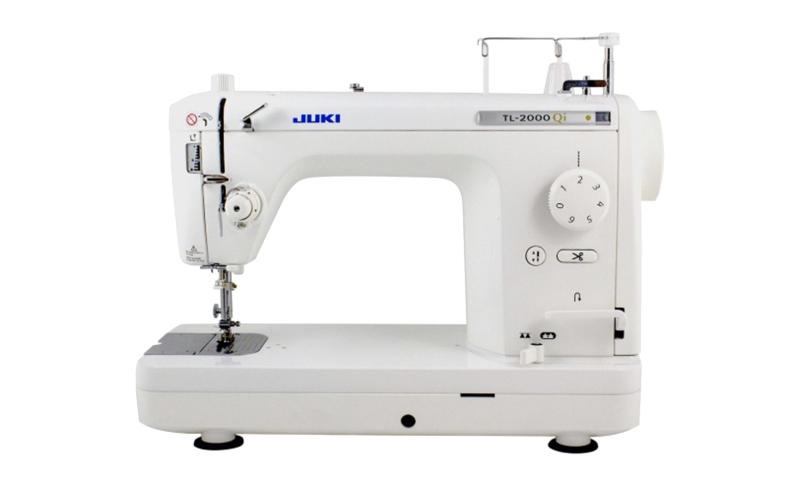
The Juki TL-2000Qi Sewing and Quilting machine is a true workhorse: it has the durability and power of an industrial machine in an accessible domestic sewing machine.
This is a large, strong and sturdy sewing machine, thanks to its all-metal chassis, entirely metal construction, and long throat. This means it can easily handle robust fabrics and many layers, though at the same time making it difficult to transport or move around too much.
The strength of the Juki TL-2000Qi Sewing and Quilting machine comes not only from its construction but also its motor. This model has a very powerful motor, delivering a staggering 1500 stitches per minute, a big time-saver for professional quilters and enthusiastic amateurs.
Also, this machine offers plenty of room for quilting, with a large throat and a wide table extender. The quilting table is fully removable, so you can use it when you need that added space to maneuver full quilts, and then reduce the footprint on your workspace when it isn’t needed.
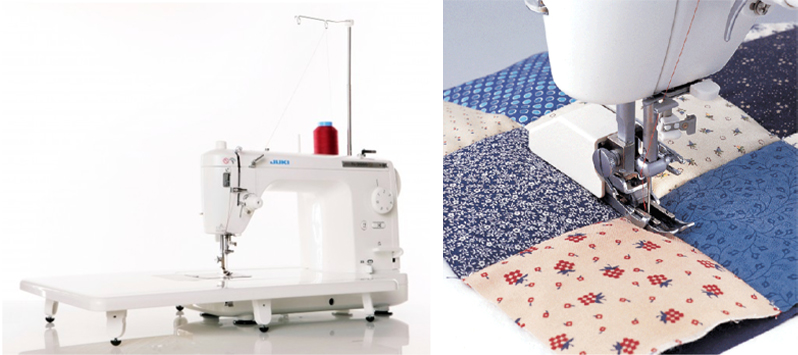
This industrial-level sewing machine produces impeccably neat stitches for professional seams every time. However, it should be noted that these perfect stitches are only available in one type of stitch.
Unlike computerized sewing machines with literally hundreds of stitches, the Juki TL-2000Qi has just one stitch option, though it does that very well.
The Juki TL-2000Qi comes with a range of accessories, including those to support clean, high-quality quilting. It comes with: even feed foot and quilting foot attachments, and also allows you to lower the feed dogs manually for free motion quilting.
Other features that will make quilting more efficient and help you to produce high-level results include:
- automatic thread trimmer
- variable-speed motor
- knee lifter to lift and lower the presser foot
- automatic needle threader
What we like:
- Strong and durable: This machine has a powerful motor which can handle robust fabrics at an incredibly fast 1500 stitches per minute.
- Wide and long throat: A large frame and particularly long a wide throat space give you plenty of room for large projects.
- Knee lifter: You can work more efficiently and sew faster by keeping your hands free and using the TL-2000Qi’s knee lifter.
- Extension Table: This model comes with a wide table extender for even more work room.
What we don’t like:
- Only one stitch option: The Juki TL-2000Qi can only do a basic straight stitch.
- Not beginner-friendly: This professional-level machine may be a bit complicated to use and will take some getting used to.
A mid-tier sewing machine, it is an affordable and accessible model, though not an entry-level one. Beginners and casual sewers will likely find it both overly complex, but more advanced and professional quilters will appreciate the number of features for the price.
This, coupled with its powerful motor and large throat (which obviously makes it great for quilting), earned the TL-2000Qi a spot among the best sewing machines for quilting.
5. Best for Quilting & Embroidery: Brother SE600 Computerized Sewing and Embroidery Machine
Read our full Brother SE600 Computerized Sewing and Embroidery Machine Review.
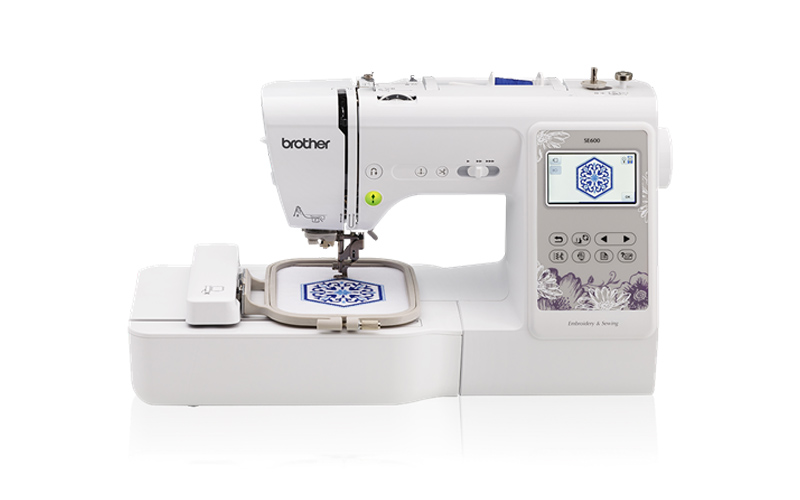
The Brother SE600 is a computerized sewing, quilting, and embroidery machine that is packed with features. Compact and easily operated, it is a solid choice for quilters who also love to embroider.
The Brother SE600 has several features that make it easy to use, even for novice sewers and quilters. This computerized sewing and quilting machine has a large color LCD touchscreen. At 3.2 inches, the touchscreen is larger than previous models, making navigating functions and selecting stitches a breeze.
There is also an automatic built in needle threader, a jam-resistant drop-in bobbin system, and a brightly lit work area. The Brother SE600 also has a free arm that allows you to sew small fiddly tasks easily and neatly. This is very handy when quilting.
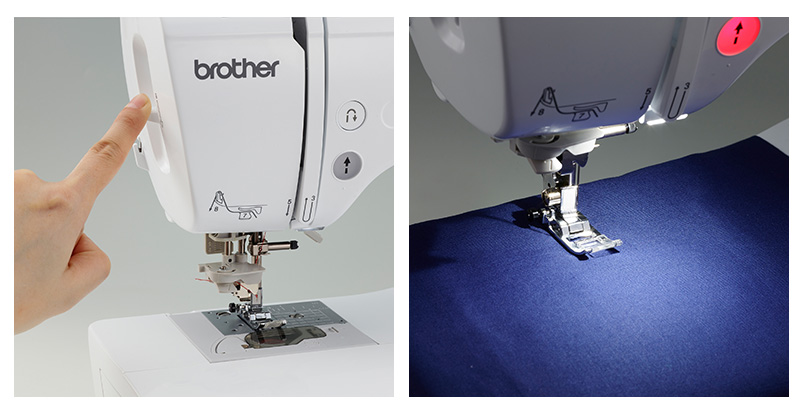
Included in the features that make the Brother SE600 ideal for quilting, is an extendable work table that gives you plenty of room to work with. At its full extension, the work table gives you a 6.4 inch by 4.1 inch workspace, with plenty of room for bulky quilts.
In total, this sewing machine has a sizable 103 built-in stitches, including decorative stitches and alpha-numeric fonts. This allows you to be creative and add those extra touches to your quilting products.
This is a great machine for not just quilting, but also embroidery, making it a great choice for those who enjoy both forms of craft.
As well as a large number of decorative stitches and embroidery lettering fonts, the Brother SE600 comes with 80 different built-in embroidery designs. If these aren’t enough for you, you can even download additional designs through its USB port.
The Brother SE600 can embroider designs up to four inches by four inches. If you want to do very large embroidery designs, you’ll need a more specialist machine.
What we like:
- Compact: The Brother SE600 is small and lightweight, making it easy to transport or store.
- Color LCD screen: This computerized model’s display screen lets you see stitches and designs in full color.
- Built-in embroidery designs: The SE600 comes with 80 embroidery designs that are ready to sew.
- USB support: You can upload even more designs to the machine through its USB port.
What we don’t like:
- No hard case included: If you want to protect your machine in transport or storage you’ll need to purchase one separately.
- Maximum embroidery area: This machine can only embroider designs up to 4 x 4 inches and so is not suitable for very large projects.
All of these features are packed into an extremely compact machine. The Brother SE600 is a very lightweight and portable sewing machine, making it easy to take with you to sewing class or stow away between uses. However, it doesn’t come with a hard case, so you will need to purchase one separately if you plan to travel with your machine often.
6. Best dedicated quilting machine: Singer Confidence Quilter 7469Q Sewing and Quilting Machine
Read our full Singer Confidence Quilter 7469Q Sewing and Quilting Machine Review.
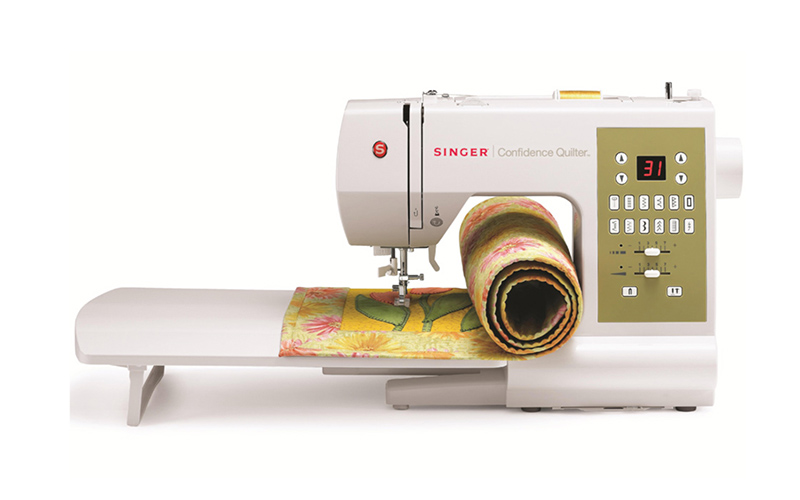
A true quilting sewing machine, the Singer Confidence Quilter 7469Q is designed specifically with quilters in mind. It has a number of features to entertain even the most advanced user, while still being easy to use for beginners.
This computerized sewing and quilting machine has a steel metal frame, making it very durable and minimizing the level of vibration. You can easily choose between its 98 built-in stitches on the 7469Q’s LCD screen, aided by the expandable stitch chart at the bottom of the machine.
Although suitable for garment and general sewing, the Singer Confidence Quilter 7469Q really comes into its own when it comes to quilting, patchwork, and appliqué. It comes with a wide extendable work table, as well as a drop feed feature for free motion quilting.
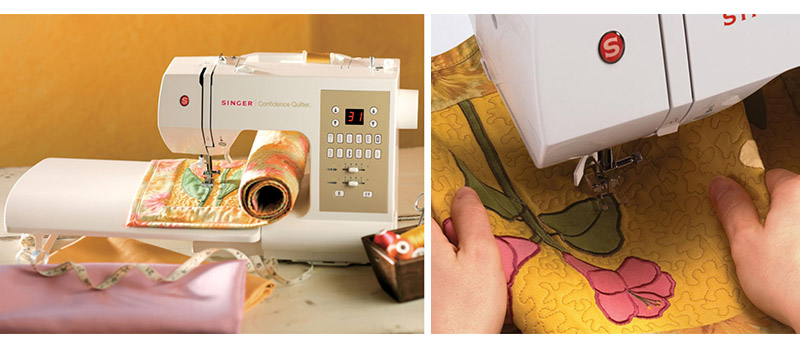
Other handy features of the Singer Confidence Quilter 7469Q include seven different one step buttonholes, jam-resistant drop-in bobbin, programmable needle stop up/down, electronic twin needle control and automatic needle threading system for easy threading of the eye of the needle.
However, there is one notable feature that is not present in this model. Most Singer computerized sewing machines these days come with a start/stop button that allows you to sew without the foot pedal. This is missing in the Singer Confidence Quilter 7469Q, meaning you need to rely the pedal, a nuance that some beginner quilters struggle to get right.
Similarly, more experienced quilters who are used to the convenience of the start/stop button may find its absence makes sewing more time-consuming. Another small drawback of this machine is its sewing speed. At 750 stitches per minute, it is slower than most comparable sewing machines.
However, this should be fast enough to satisfy most quilters, given that quilting isn’t usually a high-speed activity.
What we like:
- Built-in stitches: The Singer Confidence Quilter 7469Q has 98 built-in basic, decorative and stretch and stitches including seven automatic one step buttonholes.
- Ease-of-use: This computerized sewing machine is intuitive and easy to use, despite its many features.
- Walking Foot: A good number of accessories are included, such as a walking foot specifically designed for quilting.
- Affordable: The 7469Q has a very reasonable price tag and offers good value for money.
What we don’t like:
- No start/stop button: Sewing can only be controlled with the foot pedal, making stitching more challenging in some circumstances.
- Slow sewing speed: At 750 stitches per minute, this machine is slower than most comparable models.
Overall, the 7469Q is a great choice for anyone wanting a quilting machine with plenty of features – while remaining easy to use.
Along with a wide range of useful accessories, the 7469Q also comes with an even feed foot specifically for quilting. This model’s extra high presser foot lift also allows you to easily feed bulky quilting projects through the machine.
Although deeply satisfying when you produce a beautiful and practical quilt, it should be acknowledged that quilting projects are not the easiest.
However, having the right sewing machine for quilting makes the process much easier, and will have you turning out stunning quilts in no time.
What is a quilting sewing machine?
Quilting is a very popular form of craft with traditions that go back centuries.
In essence, quilting involves sewing together different shapes of fabric to create elaborate patterns, with stuffing added inside the layers of fabric to create a warm, cozy quilt.
Quilting techniques are used to create not only throws and quilts, but also wall hangings, bags, cushion covers, place mats and other décor items.
Traditionally, quilting was done by hand, tediously and meticulously stitching these many fiddly layers together. However, in recent years, sewing machines have evolved to allow quilters to create beautiful projects using modern and traditional quilt patterns quickly and easily.
There are now a range of quilting sewing machines available that are designed to handle the specific needs of quilters.
Do you need a special sewing machine for quilting?
Quilting sewing machines are similar to a standard sewing machine but have certain functions and features that make them suitable for quilting.
- Quilting sewing machines offer a much larger workspace than regular sewing machines, to accommodate typically large and bulky quilt projects. Sewing machines with a larger throat space offer a great workspace, that can be further expanded with an extension table.
- Most quilting machines will have both a large throat space and come with an extendable work table to offer quilters plenty of room to maneuver their large and bulky projects.
- Many quilting machines also come with special built-in stitches, like decorative and quilting stitches, beyond the standard ones you may find on a basic machine. Quilting stitches are used to hold multiple layers of fabric together. While decorative stitches are not that essential but can add an extra dimension to your quilt.
You may be able to create a simple quilt pattern on a household sewing machine, depending on the features that it has. In order to do free motion quilting, for example, the machine will need to have the ability to drop the feed dogs (the mechanism that draws the fabric through the machine).
You can essentially quilt on any sewing machine, but the more the machine has been designed with quilting in mind, the more of these kinds of features it will have.
If you will be primarily using the machine for quilting, it is worthwhile buying a machine that is made with this kind of activity in mind. On the other hand, if you are intending to both sew and quilt, a versatile machine with a range of features suitable for both techniques is the best option.
What makes a machine good for quilting?
Workspace is one of the primary concerns when quilting. Quilts, by definition, are not only large in diameter but involve many layers including bulky materials such as batting.
For this reason, when quilting, you want to have as much work space as possible to be able to maneuver large volumes of bulky fabrics without bunching or accidentally doubling up on fabric.
A machine is good for quilting if it has a large throat space to accommodate a larger working area. The best quilting machines also come with an extendable work table which can provide more sewing area, and then fold away when not needed.
Another important feature that makes a machine good for quilting is the ability to drop the feed dogs. The feed dogs are the mechanism that draws the fabric through the machine and are important for standard sewing techniques.
However, for the popular technique of free motion quilting/free motion sewing, you need to be able to drop the feed dogs on the machine. This means they will no longer touch the fabric, allowing you to completely control the flow and movement of the fabric.
The best sewing machines for quilting have a mechanism that allows you to easily drop the feed dogs for free motion sewing and then raise them again when needed.
Certain accessories also make quilting much easier and produce a better result, so the machine should ideally come with such accessories or be suitable for ones that can be purchased separately.
Certain presser feet can be highly advantageous when quilting. A free motion foot or a darning foot is essential for free motion quilting, as normal presser feet are designed to be used with the machine’s feed dogs. Therefore you need a special foot that will work with the feed dogs lowered.
A walking foot is also highly advantageous when quilting, as it allows the machine to glide smoothly over uneven layers which are common when quilting. We will discuss this particular accessory in more detail later in this article.
What to look for in a quilting sewing machine
Whether you are buying a sewing machine to use exclusively for quilting, or are after a versatile machine that can sew, quilt, and more, there are certain functions and features that you should look out for.
Large throat space
Throat space on a quilting machine is important because this influences the work space available. When making a quilt, you will be working with large amounts and multiple layers of fabric, and so you want as much space as possible.
The throat space is the area on a sewing machine behind the needle, which is the area you have to work within while sewing or quilting. The throat length refers to the space between the needle and the main part of the sewing machine.
This is opposed to the arm length, which is the entire measurement from the start of the arm to the end of the machine.
The larger the throat space, the more space you will have to work in. For quilting, you should look for a sewing machine with a throat measurement of at least 9 inches by 6 inches.
Strong motor
When looking for a sewing machine for quilting, be sure to check out the strength of the motor. Although you don’t need a very heavy-duty sewing machine as you would for sewing denim or upholstery, a strong motor is very useful when quilting.
A reasonably powerful motor will allow you to easily sew through many layers of fabric and batting which is an essential part of quilting. Look for a sewing machine model that has a motor that delivers a minimum of 850 stitches per minute.
Stitch options
When it comes down to it, you only really need one type of stitch in order to quilt: a basic straight stitch. However, as modern quilting becomes more creative, there are a range of quilting techniques that call for various stitch options.
Using interesting decorative stitches can add an extra level of interest to your quilting projects. Embroidery stitches such as alpha-numeric fonts can add a nice touch in some cases, too. Therefore, a sewing machine with a reasonable number of built-in stitches can be an advantage.
Table and free arm area
As mentioned above, work area is incredibly important when quilting. In addition to buying a machine with large throat space, the other way to ensure a large sewing space is through an extendable table.
There are a number of quilting sewing machines (including all the models listed in this article) that come with an extendable work table included. These are perfect for giving you extra work area when needed.
On the other hand, there will be times you need the smallest possible work space in order to do fiddly tasks such as when sewing small, circular items. For these times, you also want a machine that has a free arm option.
Weight and vibration
Another consideration when buying a quilting sewing machine is the weight. Lighter machines are more portable, so are better if you want to be able to take it with you to sewing class, or to be able to easily store your sewing machine when you’re not using it.
On the other hand, heavier sewing machines for quilting are generally more durable and more powerful. These can be the better option for quilters who don’t need a portable sewing machine.
Finally, look at the amount of vibration the machine generates. Models that vibrate too much while sewing are not only noisy but can cause stitches to skip. Heavy metal frame and durable construction help to limit vibrations.
Do you need a walking foot to quilt?
A walking/even feed foot works by gripping the fabric from the top as you sew. As the feed dogs pull the fabric through your machine from below, the walking foot does the same from above.
This helps to ensure an even feed and, therefore, even stitches as you sew. This isn’t really necessary if you are sewing two layers of stable, woven fabric, for example, which will be nicely fed with just the pressure of the feed dogs against the presser foot.
However, it is extremely useful when quilting, as this often involves multiple layers of different fabric as well as batting. The pulling action from the walking foot will keep all layers stable and draw them through the machine and under the needle at the same rate.
This, in turn, will produce even stitches and a polished result for your quilting project.
In this way, a walking foot is not absolutely necessary for quilting, but it is highly desirable. Without an even feed foot, beginners will struggle to achieve even stitches on their quilts. More advanced quilters may very well be able to get a good result with a regular presser foot, but will find the process much more efficient when using an even feed foot.
Wrapping it up
When it comes to buying a sewing machine for quilting, it is important to find a reliable model that includes all the essential features you need and want as a quilter.
Overall, our absolute favorite quilting sewing machine is the Juki HZL-F600 Exceed. This professional-level machine has features that will delight even the most advanced quilter and produce stunning results.
On the other hand, for entry-level sewers looking for a more simple, affordable model we would suggest the Brother CS6000i.
Have any further questions about buying the best sewing machine for quilting? Let us know in the comments below!

